Does Size Matter For Public Works Directors? Is There A Leadership Difference Between A Large Organization And A Smaller One?
By Robert R. Gordon, P.E., Director of Public Works, City of Temple Terrace Public Works Agency - City of Temple Terrace, FL; and Harry Lorick, P.E., PWLF, Principal, LA Consulting, Inc. - City of Manhattan Beach, CA
A public works organization’s size can vary from a two-member person agency to one like Los Angeles County, with nearly 4,000 members. The function is the same; maintain, operate and plan infrastructure that serves residents and visitors of the city and/or county. The skills and attributes to lead this function as Director of Public Works (DPW), however, may vary.
This article outlines what those differences are and how a director may be optimal at one size of organization, yet be marginal at another. Yet, “public works leaders need to motivate people and solve problems” (Ostrowski, 2003, p.7).
One of the key factors is span of control and the depth of an organization. Span of control is defined as the number of people a manager can supervise effectively (Lorick, 2011). When determining the differences between the management of a large organization versus those of a small organization, size does matter. How skills, styles of managing and leading a public works organization vary is important to address the unique needs of the organization. The size of the organization can affect how they plan, organize, schedule, and control their work (APWA, 2008). The implementation of these functions in the organization is often the deciding factor in their success.
A review of government organization statistics and the population they serve can give us some ideas on how DPW leadership responsibilities vary. Let’s look at Florida and the United States as a whole.
Relevant Statistics
In the U.S., there are 3,144 counties (2014), 19,492 municipal governments (2007), and 16,519 townships (U.S. Census, 2014). There are 50,432 special purpose local governments (37,381 special districts, 13,726 school districts, and 1,452 public school systems). Special purpose is sixty (60) percent of all the governments. In Florida, there are 67 counties and 178 cities (EDR, 2014). Figure 1, using data (EDR, 2014; U.S. Census, 2014), shows breakdown for both the U.S. and Florida. 61 percent of the city governments in Florida are smaller than 10,000 in populations as are nearly 87 percent of all U.S. cities. Also, in Florida 13 of the 15 largest governments are unincorporated counties with 51 percent of Florida’s residents in unincorporated areas outside of cities. In Florida, 64 percent live in cities or unincorporated counties that have populations over 100,000. Thus, most people live in larger government-controlled, political jurisdictions, but there are a lot more small governmental units. So, most DPW’s work for smaller cities.
Figure 1: Government Size Breakdown in Florida and the U.S.
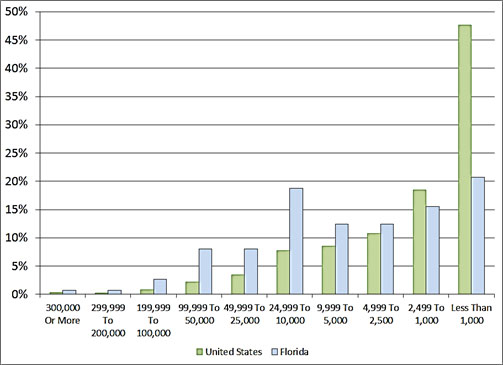
In Florida, the unincorporated counties often have the largest populations that are directly governed. This can be seen by looking at Figure 2 where eight of the top ten largest Florida governmental organizations are unincorporated counties or joint city county governments.
Figure 2: Unincorporated Cities/Counties in Florida
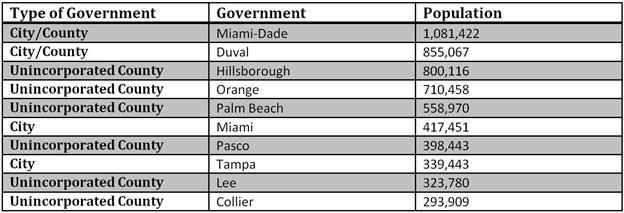
In Florida, counties play a major role, both in terms of governing a majority of the populace and in maintaining most of the public roadways under their jurisdictions. This begs the question; does this size difference make a difference in DPW leadership?
Theory
There are several management theories that can be applied to decide how to best manage a public works agency and guide a DPW to lead an organization. Two key components are the span of control and the number of layers of management which greatly influence the way an organization’s management operates (Lorick, 2011). First, the span of control as shown in Figure 3 shows some of the influential factors. Span of control is the number of subordinates that directly report to a supervisor or manager. The variability of factors listed in Figure 3 (Lorick 2011) offers insight on determining whether a narrow or wide span of control is appropriate for a given management organization. As shown, the factors of non-complex work including: similar activities performed; clearly defined objectives; formulated control rules; low risk work; and strong abilities of subordinates to get along with others; all allow for a wider span of control. For example, often 10-20 custodians are managed by one person. In work settings where complex work such as variable activities, high risk effort, and high political scrutiny exists, a narrow span of control is more likely to occur. An example of this can be seen in the case of a team of traffic design engineers that may have a span of control of just three or four engineers to one supervisor.
Figure 3: Factors Influencing Span of Control
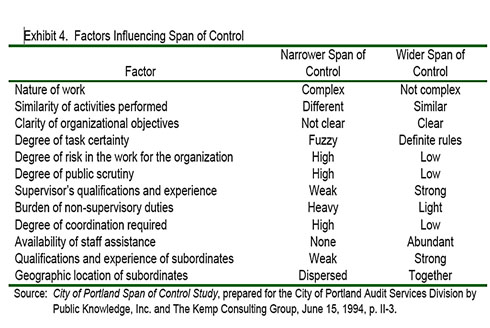
A narrow span of control, as shown in Figure 4, often has more layers and therefore more managers between work forces with a hierarchical top level of management. This has the potential for confusion of vision and need for high level of communications between top management and staff. However, it does provide greater opportunity for closer communication and direction between DPW and subordinates. Agencies with narrow management levels may benefit in that they have better communication with employees and senior management. Moreover, wide management levels often have another factor: physical separation between upper management and staff.
Figure 4: Narrow Span of Control

Agencies that implement a wide span of control with minimal layers often have better alignment with top management as shown in Figure 5. The direct communication between the top manager, DPW, and their subordinates stimulates functionality in the agency. Repetitive tasks and /or higher skilled or trained employees require less direction. In fact, small organizations with a wide span of control still often have all of the management and staff in one physical location, which allows for a low degree of coordination.
Figure 5: Wide Span of Control

Large agencies are often organized both spatially (multiple locations) and by separate function. Often, combinations of contracted and in-house services are used. Large agencies are often provided resources such as having a large professional staff with specialists in various fields as well as seasoned staff with lengthy service time. Large public works departments often have to have established structured policies and procedures. Large organizations can often be complex with both large spans and layers along spatial separation. An example of a very large organization would be the Los Angeles County Department of Public Works. The agency interfaces with 83 cities, has 4,000 employees, a $2 billion budget, and 13 levels of management from the DPW to the maintenance worker. The DPW in this organization has the responsibility of a broad array of functions such as roadways, traffic, bridges and dams, flood control, airports, beaches, water quality, potable water, sewer, solid waste, engineering, geotechnical, survey, mapping, buildings, fleet and development.
Some large agencies utilize a narrow span of control especially at management level below the DPW. A wide span of control is often found in small agencies which allows for the DPW to have clear direction and minimizes risk in the work of the organization. Large agencies face a larger degree of task uncertainty as the standard operating procedures are filtered through multiple layers of management. In addition to span of control, there are other factors that also influence the success of an organization such as the management’s skill sets and those of the employees.
Management Skill Sets
The ideal management of maintenance follows four general processes – planning, organizing, directing, and controlling (APWA, 2008). These same management processes are needed for all the various sizes of organizations but their details may vary, such as automation and complexity. The size of the agency and staff can be a factor in the type of resources used as well, whether the agency uses in-house forces or supplements services with contracted maintenance.
The skill sets required of the public works leadership varies by size of the organization. Figure 6 shows the focus of leadership (technical, human and conceptual) in organizations based on their functions (top, middle and supervisor management). These functional categories can be analogous to the size of organizations. The DPWs in Los Angeles County and Hillsborough County (FL) would most likely fit the “top management” category; whereas, a city with one or two staff in public works would be most likely to focus on specifics such as street sweeping or setting up a community event, which would be more of a “supervisory” function.
Using this theory from Kattz (1955) outlined by Northouse (2012), some implications can be concluded. For example, larger department DPW’s focus is more on their human and conceptual skills, with less need for a technical focus. The DPW of a major city or county will not often be involved in the design of an inlet or establishing a sewer cleaning cycle, but instead focus on how best to convince political leaders to fund rehabilitations of major dams in 20 years. A smaller public works DPW has more technical focus rather than conceptual, as no one staff may understand how to use a best overlay strategy and a city may be so small that long term conceptual planning is considered a minimal effort. Hence, skills needed can vary by size with larger public leadership’s focus more on human and conceptual than technical skills, while a small agency DPW requires strong technical components too.
Figure 6: Focus of Management
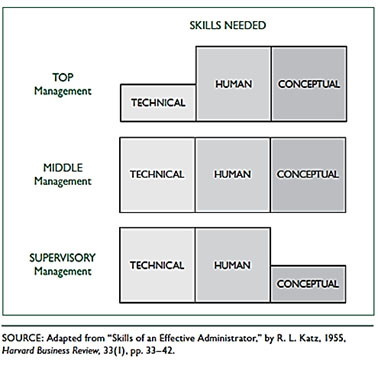
Situational Leadership Style
Another management theory that can be applied is that of leadership styles which are partially based on the skill sets of the followers. As mentioned, a larger organization will most likely have more skills and longer employment time while a smaller agency may have their DPW working on a plan review for a new store street access one day, and the next establishing a schedule for a street sweeping and snow plowing route. Those smaller agencies may have a low portion of skilled employees with most staff categorized as generalist.
Using theories outlined by Blanchard, Zigarmi & Zigarmi (1985) as explained in Northhouse (2012) may help understand which different styles may be needed. For a large agency that often have highly skilled employees that lack the need for “day to day” support for their work from the DPW. This results in the DPW’s fully delegating work assignments and responsibility to key people.
Conversely, a small city DPW with only a couple of employees may be very generalist yet must tackle a myriad of issues requiring strong coaching capabilities and a majority of work actually being led by the DPW. Figure 7 shows the four leadership styles (delegating, supporting, coaching and directing) and their behavior in support and direction for their employees, directing them to those styles which are related to their skill set and experience. Thus, the DPW’s style is related to the abilities of the employees and their needs for guidance.
Figure 7: Four Leadership Styles
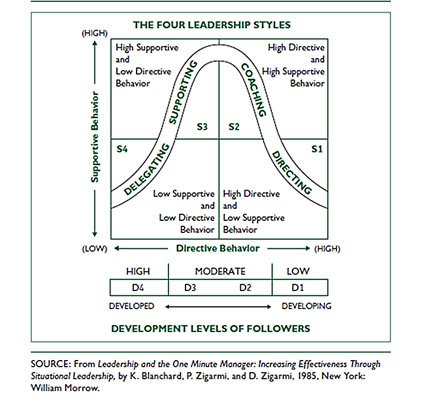
Often, DPWs of large organizations are required to possess a more general understanding, yet have more skilled technical subordinates to handle details. They must guide them by their vision and direction for the department. They must have an overall policy understanding of political issues and be able to coordinate efficiently within and without their organization. Governmental and intergovernmental interaction is imperative, along with their media communications and public relations. Those leaders must be flexible and interface with political leadership. Their focus should first be on the people, and then the results of the work of the department. They must focus on delegating that work, and encouraging and motivating their staff. Obtaining and retaining key management staff will help them to achieve their goals. This can be seen in quadrant S3 and S4 in Figure 7.
For smaller organizations though, many of the same organizational and leadership issues exist yet normally the problems are lower in magnitude. However, lower skills and the background of the staff may require direct involvement by the DPW in the actual work completion and decision making. Except for non-routine issues, the DPW may have to be the department’s technical leader and coach to employees, directing them to make specific decisions for the completion of tasks. For example, in a small city, the sizing of a replacement for a failed drainage pipe may have to be done by the DPW, where in a big agency it would be done by delegation to the drainage design unit. A small departments’ DPW would be expected to work in quadrant S1 and S2 in Figure 7.
Theoretical Implications
The theoretical concepts described above can be translated into implications for public works. Overall, there are many differences in the makeup and processes of large and small public works organizations. Large agencies are often structured with smaller spans of control but more layers. Some groups may be physically located in different parts of the community. Further, large agency DPW focuses more on conceptual issues with a strong focus on human interfaces, including citizen and political leaders. Much of the technical skills reside in highly-trained subordinates who are directed through management and leadership attributes of the DPW, which is also dependent upon the style used by the large agency on delegations to specialty units or contracts for work such as traffic signal design or sewer line cleaning. Also, leadership concepts employed by the DPW of large public works agencies typically include a supporting role in the provision of resources and delegation of tasks and technical assignments to employees.
Contrary to this case is a small agency’s DPW, which often has a large span of control as it is less complex and fewer managers exist; the depth of number of layers is smaller with some having only one to two layers from the highest to the lowest employee in the department. The capabilities of the staff play a key role in what work the department can do. Because of a lack of technical support and a need for less long term planning, many technical issues are often covered by the DPW in small agencies.
Further, because of less skilled and technical staff, the small agency DPW has to give more explicit direction to staff and use coaching and direct supervision to accomplish tasks. To further look at these ideas the following is an examination of a City that retained a seasoned big agency DPW who managed nearly 700 employees to become the DPW at a smaller public works with only 60 employees, but had more functions including fleet, utilities and solid waste.
A Working Example
The City of Temple Terrace (TT), Florida has 6.9 square miles and a population of 25,189, and is considered a mid-sized Florida city. The city has 60 positions that offer many services which include the management of roadways, traffic, water quality, potable water, sewer, solid waste, engineering, geotechnical, survey, mapping, facility, fleet maintenance, and development review. The City has a wide span of control as shown in Figure 8. There are three (3) management levels from director to maintenance worker. Therefore, this allows establishment of personal relationships with employees at all levels. Because the City is responsible for multiple functions, the DPW must work at a combination of political, administrative, and technical levels. The City interfaces directly with various departments, but the DPW is often required to be the technical expert or manage a contract for one. The DPW of a much smaller organization must combine human, technical, and conceptual skills when in the prior assignment, the director simply delegated work assignments with focus on human and political skills to help move and explain work efforts to elected leaders and citizens.
Yet in TT, the Directors’ role changed and he is now directly involved in “day to day” operational decisions. The DPW must now communicate with all employees to achieve goals as they are the key technical person. The city size results in less bureaucracy which allows the director more freedom to act and a personal face can be put on work flows and processes. A DPW for TT is now involved and makes more decisions in all levels of the department’s work. The issues within TT reflect those of other small agencies, where the issues are numerous though not overly complex and require a DPW to be involved in many functions. The functions of the department are the same as any other department of large public works, yet with less staff that has the required skill sets. In TT, because the DPW was willing to redevelop his skill set to be more operational, his focus has proved successful. Yet it did take a change and understanding of this situation which occurred over a six month period. Some DPW’s may not have such ability or the desire to change.
Figure 8: Temple Terrace Public Works Department Functional Organization Chart
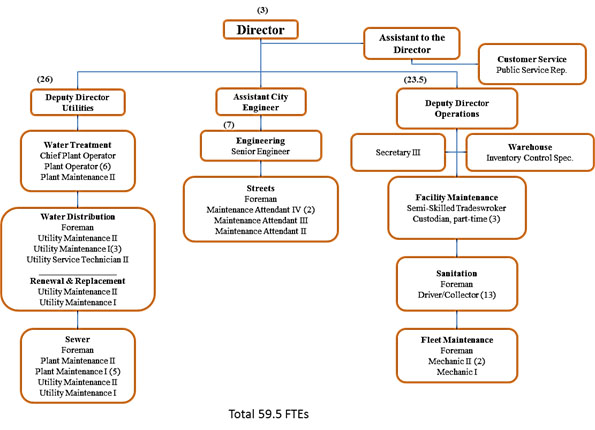
Conclusion
Public works operations follow established management principals and are affected by size. The DPW’s attributes, skills and management styles are influenced by the capabilities of the staff and the DPW, as well as the scope of the work.
As shown in our examination of Temple Terrace, an experienced DPW working for 20-plus years for a very large public works agency had to modify his approach when assuming the size of a smaller agency. He had to get closer to the work and has had to direct and coach more as his staff consists of fewer specialists which makes it necessary to cover many different disciplines. Hence, DPW roles vary by size and depend on their background and people skills; also the management style, which can be efficient at one size agency yet not nearly as successful in another.
The size difference does impact the way one must manage and lead a department as demonstrated by the leadership theories presented here and in our practical example, yet the basic purposes and functions of Public Works are the same.
References
APWA (2008). Public works administration. Kansas City, Missouri: American Public Works Association.
Blanchard, K., Zigarmi, P., & Zigarmi, D. (1985). Leadership and the one minute manager: Increasing effectiveness through situational leadership. New York: William Morrow.
Katz, R. L. (1955). Skills of an effective administrator. Harvard Business Review, 33(1), 33–42.
Lorick, J. (2011). Span of control impacts public works efficiency. APWA Reporter, 79(2), 36-39.
Northouse, P. G. (2013). Leadership: Theory and practice (6th ed.). Washington, DC: Sage Publications.
Ostrowski, J. (2003). Everything you need to know to be a public works director. Kansas City, Missouri: American Public Works Association.
The Florida Office of Economic and Demographic Research (EDR). (2014). Population and demographic data. Retrieved from http://edr.state.fl.us/Content/population-demographics/data/
United States Census. (2014). Population of interest- municipalities and townships. Retrieved from https://www.census.gov/govs/go/municipal_township_govs.html
